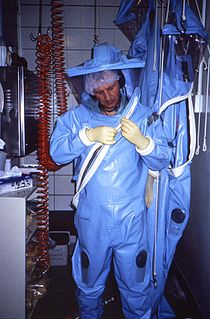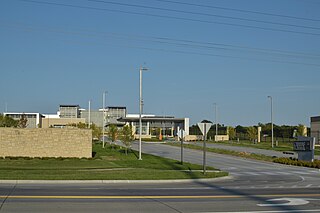
Biosafety is the prevention of large-scale loss of biological integrity, focusing both on ecology and human health. These prevention mechanisms include conduction of regular reviews of the biosafety in laboratory settings, as well as strict guidelines to follow. Biosafety is used to protect from harmful incidents. Many laboratories handling biohazards employ an ongoing risk management assessment and enforcement process for biosafety. Failures to follow such protocols can lead to increased risk of exposure to biohazards or pathogens. Human error and poor technique contribute to unnecessary exposure and compromise the best safeguards set into place for protection.

A biosafety level (BSL), or pathogen/protection level, is a set of biocontainment precautions required to isolate dangerous biological agents in an enclosed laboratory facility. The levels of containment range from the lowest biosafety level 1 (BSL-1) to the highest at level 4 (BSL-4). In the United States, the Centers for Disease Control and Prevention (CDC) have specified these levels. In the European Union, the same biosafety levels are defined in a directive. In Canada the four levels are known as Containment Levels. Facilities with these designations are also sometimes given as P1 through P4, as in the term P3 laboratory.

Fort Detrick is a United States Army Futures Command installation located in Frederick, Maryland. Historically, Fort Detrick was the center of the U.S. biological weapons program from 1943 to 1969. Since the discontinuation of that program, it has hosted most elements of the United States biological defense program.

Plum Island Animal Disease Center (PIADC) is a United States federal research facility dedicated to the study of foreign animal diseases of livestock. It is part of the Department of Homeland Security Directorate for Science and Technology, and operates as a partnership with the U.S. Department of Agriculture. The facility's director is Dr. Larry Barrett.

The University of Texas Medical Branch (UTMB) is a public academic health science center in Galveston, Texas. It is part of the University of Texas System. UTMB includes the oldest medical school in Texas, and has about 11,000 employees. In February 2019, it received an endowment of $560 million.

Battelle Memorial Institute is a private nonprofit applied science and technology development company headquartered in Columbus, Ohio. Battelle is a charitable trust organized as a nonprofit corporation under the laws of the State of Ohio and is exempt from taxation under Section 501(c)(3) of the Internal Revenue Code because it is organized for charitable, scientific and education purposes.

The United States Army Medical Research Institute of Infectious Diseases is the U.S Army's main institution and facility for defensive research into countermeasures against biological warfare. It is located on Fort Detrick, Maryland and is a subordinate lab of the U.S. Army Medical Research and Development Command (USAMRDC), headquartered on the same installation.

WSP USA, formerly WSP|Parsons Brinckerhoff and Parsons Brinckerhoff, is a multinational engineering and design firm with approximately 14,000 employees. The firm operates in the fields of strategic consulting, planning, engineering, construction management, energy, infrastructure and community planning. In 2013, the company was named the tenth largest U.S.-based engineering/design firm by Engineering News Record. In 2020, it was ranked #7 of the Top 500 Design Firms and #2 of the Top 100 Pure Designers by the same magazine. On October 31, 2014, Parsons Brinckerhoff became a wholly owned independent subsidiary of WSP Global, a Canadian-based professional services firm. Parsons Brinckerhoff was renamed to WSP|Parsons Brinckerhoff, then to WSP USA in 2017. Together with WSP Global, WSP USA is one of the largest professional services firms in the world, with approximately 31,500 employees in 500 offices serving 39 countries.
The National Biodefense Analysis and Countermeasures Center (NBACC) is a government biodefense research laboratory created by the U.S. Department of Homeland Security (DHS) and located at the sprawling biodefense campus at Fort Detrick in Frederick, MD, USA. The NBACC is the principal U.S. biodefense research institution engaged in laboratory-based threat assessment and bioforensics. NBACC is an important part of the National Interagency Biodefense Campus (NIBC) also located at Fort Detrick for the US Army, National Institutes of Health and the US Department of Agriculture.

HDR, Inc. is an employee-owned design firm, specializing in engineering, architecture, environmental, and construction services. HDR has worked on projects in all 50 U.S. states and in 60 countries, including notable projects such as the Hoover Dam Bypass, Fort Belvoir Community Hospital, and Roslin Institute building. The firm employs over 11,000 professionals and represents hundreds of disciplines in various markets. HDR is the 10th largest employee-owned company in the United States with revenues of $2.5 billion in 2021. Engineering News-Record ranked HDR as the 5th largest design firm in the United States in 2022.

The National Bio and Agro-Defense Facility (NBAF) is a biosafety level 4 research laboratory in Manhattan, Kansas, operated by the United States Department of Agriculture. Slated to open in Summer 2022, the facility is designed to combat biological threats involving human, zoonotic, and foreign animal diseases. The NBAF will be replacing the aging Plum Island Animal Disease Center (PIADC) on Plum Island, New York. The primary research tenants of the facility will be the Agriculture Research Service (USDA-ARS) and Animal Plant Health Inspection Service, Veterinary Services (USDA-APHIS-VS). Construction on the 574,000-square-foot (53,300 m2) facility officially began in May 2015, and was scheduled to be completed by May 2021. The ongoing COVID-19 pandemic, however, has delayed scheduled commissioning to October 2021, followed by further delays to Spring, and, subsequently, Summer 2022. Operations will be fully transferred from the Plum Island facility by 2023. When fully operational, the facility will employ between 250 and 350 people. The facility is a constituent member of the Biosafety Level 4 Zoonotic Laboratory Network, and is currently led by Alfonso Clavijo.
Black & Veatch (BV) is the largest engineering firm in the Kansas City metropolitan area. Founded in 1915 in Kansas City, Missouri it is now headquartered in Overland Park, Kansas It is a global engineering, procurement, construction (EPC) and consulting company specializing in infrastructure development in power, oil and gas, water, telecommunications, government, mining, data centers, smart cities and banking and finance markets.
Clarence James Peters, Jr is a physician, field virologist and former U.S. Army colonel. He is noted for his efforts in trying to stem epidemics of exotic infectious diseases such as the Ebola virus, Hanta virus and Rift Valley fever (RVF). He is an eminent authority on the virology, pathogenesis and epidemiology of hemorrhagic fever viruses.
The Canadian Science Centre for Human and Animal Health (CSCHAH) is an infectious disease laboratory complex in Winnipeg, Manitoba, owned and operated by the Government of Canada. This modern facility is home to two laboratories: the Public Health Agency of Canada's National Microbiology Laboratory (NML) and the Canadian Food Inspection Agency's National Centre for Foreign Animal Disease (NCFAD). It is the workplace of approximately 500 federal employees.

The Oregon PHL/DEQ Laboratories are the Oregon Department of Environmental Quality (DEQ) and Oregon Department of Human Services (DHS) laboratories located in a single building in Hillsboro, Oregon, United States. DHS operates the Oregon State Public Health Laboratory (OSPHL), and the DEQ operates their Laboratory and Environmental Assessment Division at the site. The laboratories previously were located at Portland State University, moving to the new location near Cornelius Pass Road and the Sunset Highway in northeast Hillsboro in 2007.

The Galveston National Laboratory (GNL) in Galveston, Texas, United States, is a high security National Biocontainment Laboratory housing several Biosafety level 4 research laboratories. The lab is run by the University of Texas Medical Branch (UTMB) for exotic disease diagnosis and research. The GNL is one of the 15 biosecurity level 4 facilities in the United States and the largest one in the world located on an academic campus.
Flad Architects is a national architectural firm with offices in Madison, Wisconsin; Atlanta, Georgia; Gainesville and Tampa, Florida; Raleigh, North Carolina; San Francisco, California, Seattle, Washington; and New York, New York. In addition to architectural design, Flad offers interior design, landscape architecture, master planning, strategic planning, structural engineering, and sustainable design services. The firm is involved in multiple markets and building types including: corporate, healthcare, higher education, science and technology, and the federal government.
The United States biological defense program—in recent years also called the National Biodefense Strategy—refers to the collective effort by all levels of government, along with private enterprise and other stakeholders, in the United States to carry out biodefense activities.
This article summarizes healthcare in Texas. In 2017, the United Healthcare Foundation ranked Texas as the 34th healthiest state in the United States. Obesity, excessive drinking, maternal mortality, infant mortality, and vaccinations are among the major public health issues facing Texas.

The Wuhan Institute of Virology, Chinese Academy of Sciences is a research institute on virology administered by the Chinese Academy of Sciences (CAS), which reports to the State Council of the People's Republic of China. The institute is one of nine independent organisations in the Wuhan Branch of the CAS. Located in Jiangxia District, Wuhan, Hubei, it opened mainland China's first biosafety level 4 (BSL-4) laboratory. The institute has collaborated with the Galveston National Laboratory in the United States, the Centre International de Recherche en Infectiologie in France, and the National Microbiology Laboratory in Canada. The institute has been an active premier research center for the study of coronaviruses.













